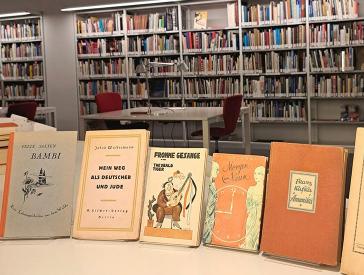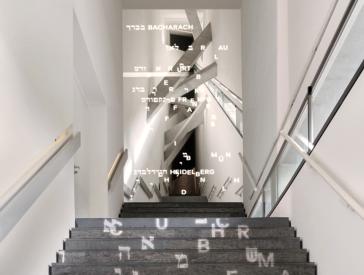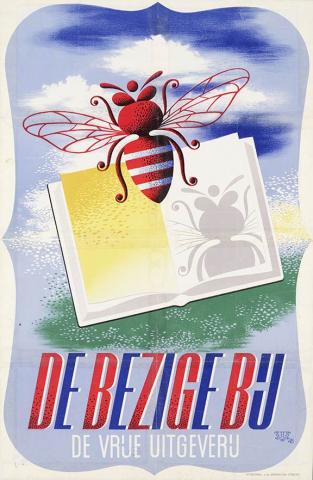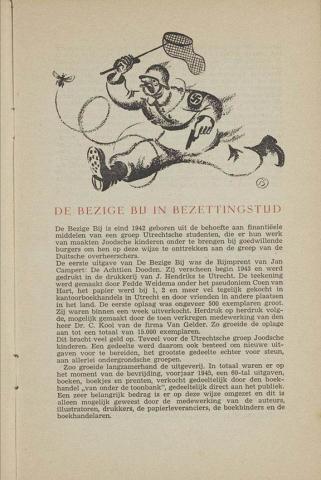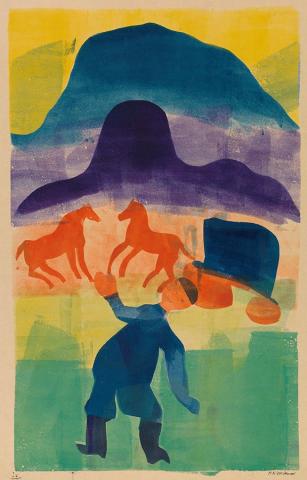Clandestine Literature in the Netherlands 1940–1945
Dutch clandestine literature developed in opposition to German policy and its strict control over the media during the Nazi-occupation. It was essentially spiritual resistance against the aggression. In no other country under German occupation more clandestine literature was published than in the Netherlands.
Following the devastating bombardment of Rotterdam on May 14, 1940, the Dutch army surrendered to Nazi Germany. Soon after, control over the Netherlands passed from a German military to a civilian government, led by the Austrian Arthur Seyss-Inquart. The choice of Seyss-Inquart can be interpreted as a reflection of Hitler’s long-term ambitions with the Netherlands: the Nazification of the country, followed by its absorption into a greater Germany, similar to what had occurred to Austria.
As Reich Commissioner, Seyss-Inquart tightened Nazi control over the media. Bookshops and libraries were cleansed of “anti-German” literature, and censorship bureaus imposed strict controls over new publications. In November 1941, he also established the Kultuurkamer (Chamber of Culture). As is reflected in its spelling of the word kultuur (with the German “k” instead of the Dutch “c”), its task was to push along the Germanization of Dutch literature. In opposition against this policy, Dutch clandestine literature developed. The latter is a general term for all literature that was published without permission from the German authorities. Some of these works openly challenged the occupier, whereas other books only dealt with general themes that for specific reasons were in defiance of Nazi regulations. In both cases the authors, editors and printers risked their lives in defense of freedom of the press, thought and artistic expression. At least 700 men and women of the underground press perished during the occupation.
In no other country under German occupation more clandestine literature was published than in the Netherlands. In Het vrije boek in onvrije tijd (The Free Book in an Unfree Time, 1958), Dirk de Jong identified over a thousand titles. Perhaps even more impressive than the number of publications was the unprecedented popularity of clandestine literature, poetry bundles in particular, some of which sold over 40,000 copies.
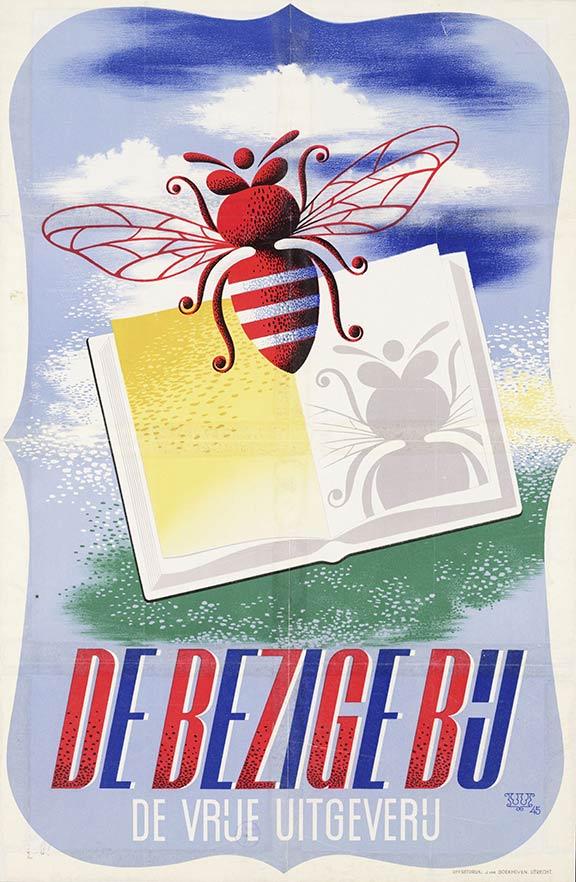
Poster of the independent publishing house De Bezige Bij, 1945 The Amsterdam clandestine publishing house published the most extensive program during the German occupation. After the war, De Bezige Bij became the largest literary publishing house in the Netherlands; NIOD
Dutch Clandestine Books
The fact that the Nazis imposed stricter regulations than elsewhere in occupied Europe accounts not only for the high number of clandestinely printed book titles, but also for their content. The aggressive German policy was felt as an attack against the Dutch way of life, shared values and familiar conceptions of freedom and justice. Dutch clandestine literature was essentially spiritual resistance against this Nazi aggression and, at its core, deeply patriotic. Its main ambition was to oppose German propaganda by preserving self-respect and allegiance to democratic and national ideals. The armed resistance as such was not the dominant topic of clandestine literature. Rather, its focus was on the spiritual, humanitarian and historical-nationalistic motives that were considered essential elements of Dutch identity.
This ambition reflected itself in the production of countless poems and stories in which an emotional connection to ordinary, yet highly symbolic, elements was recovered, such as an old city center or a typically Dutch landscape. Even poems that referred to the persecution of Jews tended to be patriotic in the sense that German anti-Semitism was contrasted by the Jewish community’s century-old attachment to the Netherlands. The Germans and their Dutch collaborators, on the other hand, were often the victim of mockery and scold. In their simplicity or vulgarity, such poems could easily be memorized.
The largest clandestine publishing house was De Bezige Bij (The Busy Bee), founded by Geert Lubberhuizen. Lubberhuizen was linked to a group of students from Utrecht University who had formed a committee to help Jewish children in hiding. The group saved the lives of some 400 children. Without Lubberhuizen’s financial support this would not have been possible. In 1943 he had published an illustrated broadsheet of Jan Campert’s dramatic poem “De achttien dooden” (The Eighteen Dead) about the first group of Dutch resistance members who were executed in 1941. Some 15,000 copies of the broadsheet were sold, which brought in so much money that it could secure not only the subsistence of the Jewish children, but also the financial basis for a clandestine publishing company. Unlike its French counterpart Les Éditions de Minuit, whose concern for saving the honor of French thought was reflected in the high literary quality of its publications, De Bezige Bij published anything that could bring in money, from poems by Edgar Allan Poe and Guy de Maupassant to postcards with caricatures of the Nazis.
In terms of artistic quality, Hendrik Werkman’s publications for De Blauwe Schuit (The Blue Bark) were exceptional. Among its most famous editions are the beautifully illustrated Chassidische legenden (Hasidic Legends, since 1941), based on Martin Buber’s edition of Jewish mystic tales. In March 1945 the police raided Werkman’s office; he was summarily arrested and executed.
There were hundreds of similar small-scale (and often dilettantish) clandestine publishing houses all over the Netherlands. Their print numbers were usually limited; in 25% of cases, fewer than a hundred copies per book were printed. As the use of noisy printing machines implied a serious risk, most of these publishers used lithography as their printing method, often in combination with a primitive hand press, a hectograph, a platen press that had to be powered by foot or, as a last resort, a mimeograph. Another problem was paper shortage. Since the Chamber of Culture had a monopoly in the distribution of paper for book printing, clandestine books relied on stolen paper and were, thus, usually thin. This also explains why most of the production of clandestine literature consisted of poetry and short stories.

Excerpt from an booklet published by De Bezige Bij, 1945 The booklet also contained a list of publications published during the war; NIOD
Relevance of Clandestine Literature
Dutch literary histories have traditionally paid little attention to clandestine literature. Scholars tended to look at 1945 as a “Year Zero,” as if Dutch literature restarted from scratch after the war, and focused on to the rebellious postwar generation. However, many of the “new” tendencies in the late 1940s were already present in clandestine literature. Anna Blaman’s openly lesbian novel Eenzaam avontuur (Lonely Adventure, 1948), for instance, was preceded by her clandestinely published story Ontmoeting met Selma (Encounter with Selma, 1943). Rein Blijstra’s libertarian sexual morality, his relativistic approach to a the resistance and his deep-seated cynicism in Bij nadere kennismaking (Upon Further Acquaintance, 1944) make him, together with Blaman, a herald of changing moral values in Dutch literature. Blijstra’s other clandestine publication, Haaien voor Nabatoe (Sharks near Nabatu, 1945), is also exceptional because of its anti-colonial message. With this novel, Blijstra pointed to a discussion that would flare up in Dutch society soon after the liberation: how can a country that justified its resistance as a fight for freedom still defend the rightness of a colonial empire?
As these examples show, the prejudice that clandestine literature has little more to offer than a simplistic celebration of Dutch patriotism is unfair. In fact, a considerable part of this literature consists of translated work by Kafka, Baudelaire, Dickinson, even Omar Khayyam and James Langston Hughes — hardly names that reflect a reactionary conception of literature.
Clandestine literature also contains the first Dutch ego-document on the Holocaust. Long before Anne Frank’s diary was published, letters written by Etty Hillesum from Westerbork Camp were printed clandestinely in the camouflaged publication (“Tarnschrift”) Drie brieven van den Kunstschilder Johannes Baptiste van der Pluym (Three Letters by the Painter Johannes Baptiste van der Pluym, 1943). Another fascinating Tarnschrift is Albert Helman’s Aldus sprak Zarathustra (Thus Spoke Zarathustra, 1944), a critical portrait of Germany’s authoritarian history composed of quotes taken from German authors such as Christian Schubart, Ludwig Tieck, Ludwig Börne and Heinrich Heine.
Few poems in Dutch literature contain a more radical confrontation with existential questions than those of Herman Salomonson in Recrutenschool (School for Recruits, 1941). As a “crusader of Christ,” Salomonson opposed Nazism from a Christian perspective and condemned the cowardice of all those who before the invasion spoke loudly about resistance but became silent as soon as danger threatened. The assumption that critical voices about the general passiveness of the Dutch population during the occupation could only be heard after the liberation is, in fact, a myth. Those voices were to be heard loud and clearly in clandestine literature by authors who not only anticipated the rebellious post-war generation of the 1960s in their criticism but did so at a time when protest could have deadly consequences. One of the most touching examples is Martinus Nijhoff’s new version of his poem “De kinderkruistocht” (The Children’s Crusade). While the previous version dealt with a topic from a vague past, “Moderne kinderkruistocht” points angrily at the passive and sometimes even collaborative attitude in Dutch society vis-à-vis the Jewish children’s drama that was taking place before the public’s eyes. Perhaps more than anything else, however, the importance of clandestine literature lies in the fact that faith in the written word could be maintained. It is remarkable that the belief in the power of literature reached its height in the Netherlands precisely at a time when German propaganda misused literature in such a way that the traditional perception of printing as an ally of humanism became corrupted. In the occupied Netherlands, clandestine printing had been able to produce a contrast to this abuse of literature. Its aesthetic quality was perhaps not as bright as some had hoped, but at a time of total darkness, even the smallest flame sheds a lot of light.
This article offers a summary, in slightly revised form, of Spirit of Resistance: Dutch Clandestine Literature during the Nazi Occupation. Rochester, NY: Camden House, 2010.
Jeroen Dewulf is Professor at the UC Berkeley Department of German & Dutch Studies. As the incumbent of the Queen Beatrix Chair, he is director of Berkeley’s Dutch Studies Program. His areas of specialization are Colonial history, Language and Identity, Cultural Anthropology, Postcolonial and Cosmopolitan Theory.
This article was first published in 2024 in issue 26 of the print edition of the JMB Journal.
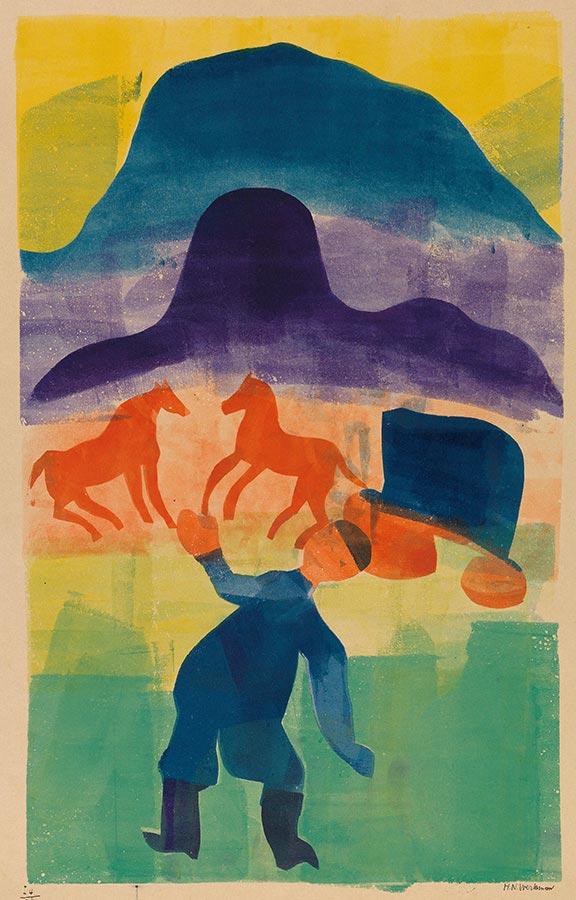
H. N. Werkman (1882–1945), illustration for "De gedwongen terugkeer" [The Forced Return], in: Chassidische Legenden I, 1942; Koninklijke Bibliotheek
Citation recommendation:
Jeroen Dewulf (2024), Clandestine Literature in the Netherlands 1940–1945 .
URL: www.jmberlin.de/en/node/10287
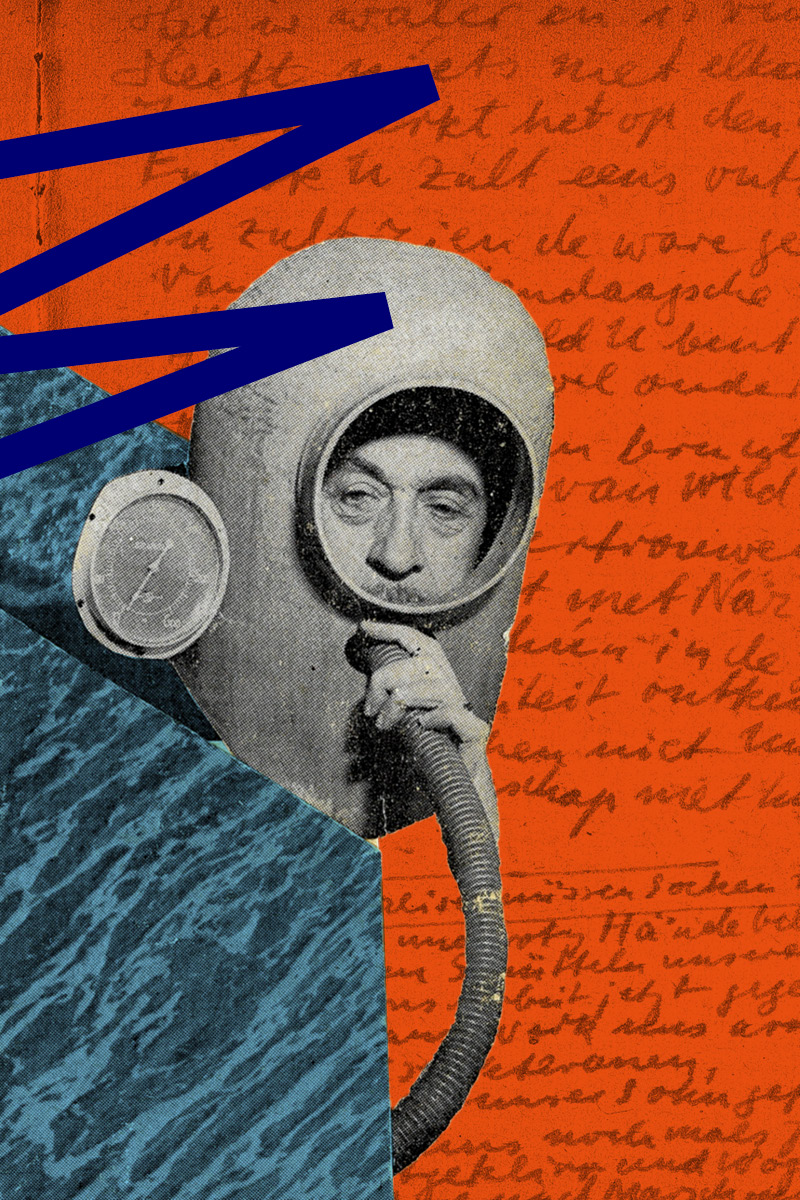
Exhibition “My Verses are Like Dynamite” Curt Bloch’s Het Onderwater Cabaret: Features & Programs
- Exhibition Webpage
- “My Verses are Like Dynamite” Curt Bloch’s Het Onderwater Cabaret: 9 Feb to 23 Jun 2024
- Accompanying Events
- Tour of the Exhibition “My Verses are Like Dynamite” Curt Bloch’s Het Onderwater Cabaret: Dates by arrangement (from 9 Feb to 26 May 2024)
- Exhibition Opening: 8 Feb 2024
- Curator Tour for FRIENDS OF THE JMB: 8 Apr 2024, in German
- Joodse Vluchtelingen: The Fate of German-Jewish Émigrés in the Netherlands: 3 Mar 2024, in German
- Archival Objects of German Jews in the Netherlands: Show & tell for FRIENDS OF THE JMB, 7 Mar 2024, in German
- Het Onderwater Cabaret Live. An evening of music and poetry: 11 Apr 2024, in German
- Hidden in Enschede: Conversation with Contemporary Witness Herbert Zwartz: 16 Apr 2024, in German
- Publications
- JMB Journal 26: Het Onderwater Cabaret: Special edition on the occasion of the exhibition
- Digital Content
- OWC Online Feature: A Glimpse Behind the Scenes of the Exhibition
- Life and Work of Curt Bloch: Essay with biographical insights, JMB Journal 26
- On the Piano of My Fantasy – Video with Marina Frenk, Richard Gonlag, and Mathias Schäfer, in German, Dutch and German Sign Language
- “It’s Complicated”: A text by Simone Bloch, daughter of Curt Bloch
- “Ik neurie mee ’t propellerlied…”: Essay on Het Onderwater-Cabaret: A Testament to Political Resistance in the Occupied Netherlands, 1943–45
- Current page: Clandestine Literature in the Netherlands 1940–1945: Essay, JMB Journal 26
- All Audio Pieces of the Exhibition with Transcriptions and Translations
- All issues of Het Onderwarter-Cabaret: All 95 issues to browse
- See also
- Survivors in Hiding (National Socialism)
- To the Web Project www.curt-bloch.com
